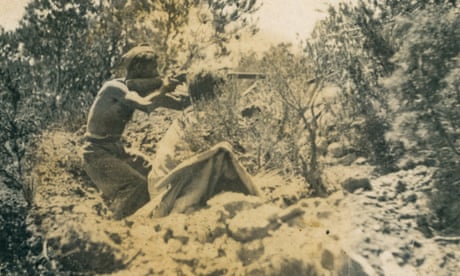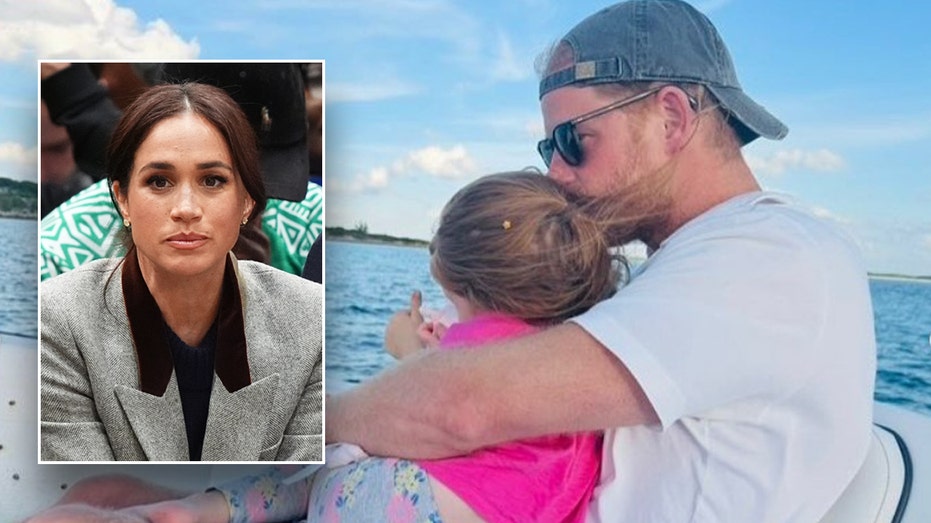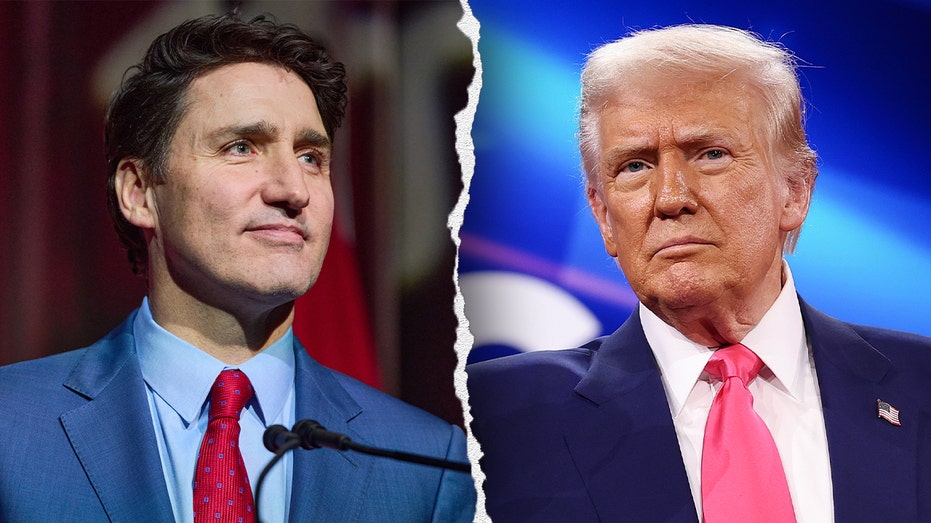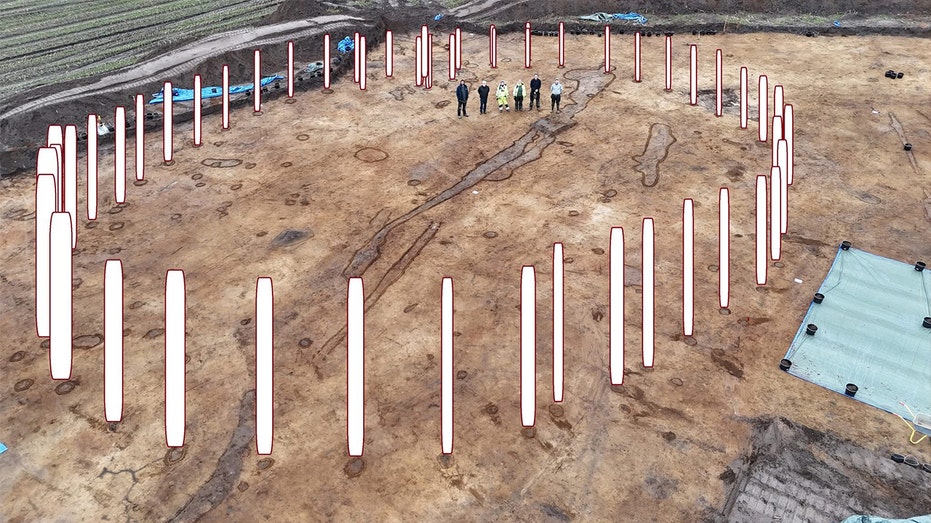- by foxnews
- 10 Mar 2025
‘Brothers in arms, a long way from home’: the first Australians to fight fascism overseas
‘Brothers in arms, a long way from home’: the first Australians to fight fascism overseas
- by theguardian
- 30 Apr 2023
- in news

The grainy, sepia photograph shows two men, an Australian and a New Zealander. Sydney dock worker Jack Franklyn is partly obscured by bush, leaning forward, his rifle poised and ready. New Zealander Bert Bryan, bare-chested and wearing a beret, crouches at the edge of a trench while shooting at the enemy. They're in Spain, the battle of Ebro in 1938, and the fact they are fighting together in one of the Spanish civil war's most seminal and bloody battles lends a gritty new dimension to the revered legend of Anzac.
The photograph was recently discovered among personal mementoes in the western Sydney home of 80-year-old Vanessa McNeill. Her father, Wollongong steel worker Jim McNeill fought the fascists alongside Bryan and Franklyn at Ebro, which began 85 years ago this July. McNeill was shot by a machine gun at Ebro, his second wounding in Spain.
McNeill entrusted the photograph, along with a dusty suitcase of her father's papers, photographs, postcards, publications, and castanets with ribbons in the colours of the fallen Spanish Republic to historian Michael Samaras. Samaras placed most of the material with the local Illawarra Museum, and now he is offering the photo to the Australian War Memorial.
Despite Australia's obsessive celebration of overseas military conflicts since colonial days, the experiences of its people who fought and died in the Spanish civil war rate barely a mention in official military history or commemoration.
Their remarkable stories might be known to their now aged children and, perhaps, grandchildren. And the actions of a few have been chronicled in books. They were certainly covered in contemporary newspapers. But the 70 or so Australians who joined the International Brigades to fight or serve as nurses in support of the Spanish Republic's bitter, failed military resistance to Franco's fascist forces are not acknowledged.
This, despite the fact that all of the volunteers were precocious military opponents of global fascism when many countries - including the conservative Menzies government of Australia - were still set on appeasement of fascist leaders like Franco and Hitler. Indeed, some of the Australian International Brigadiers had previously battled the fascist New Guard on Australia's streets in the early 1930s. Others, meanwhile, returned from the Spanish civil war and immediately signed up to fight fascist Nazi Germany and Italy in the second world war once Australia joined.
The incredible stories - of why they volunteered, how they reached Spain, their experiences of combat, their unlikely survival and their deaths - deserve formal national remembrance. That most of those Australians who served in the International Brigades were of the sharp left - including many communists and unionists - doubtless contributes to the official amnesia about them.
Consequently, most of the personal collections - letters, postcards, journal writings, photographs and ephemera - of the Australians who went and returned have probably been confined to boxes in suburban attics and sheds or worse, to landfill.
That's why the discovery of the photograph is so significant; it might be the only known photograph that depicts an Australian fighting in the Spanish civil war.
"It is a powerful image," says Samaras. "There they are, an Australian and a New Zealander, brothers in arms, a long way from home, fighting a doomed campaign. The Anzac echoes are strong, however members of the International Brigades did not go to war because their government sent them, they were instead motivated by deeply felt personal convictions.
"There are a handful of photographs of Australian members of the International Brigades in reserve [conflict] areas, but this is the only photo I've seen of them in action. If anyone has another, it would be great to see it," Samaras says.
On the reverse side of the photograph, beneath the names of Bryan and Franklyn, is written in McNeill's hand:
Hill 481 near Gandesa [Battle of Ebro]
Where Bill Young died
It is unclear if McNeill took the photograph. But it is invaluable, regardless, for its evocation of the experiences - and post-International Brigades life - of several Australians and the New Zealander, Bryan. A portal into their pasts and futures.
Bill Young is described in a May 1948 booklet, Australians In Spain, as having been known in the International Brigades as "the Big Aussie".
He worked in the bush and in construction, and was member of the Communist party (like McNeill and Carter) before stowing away on a coal bunker set for Europe. After he was discovered the ship, two hands short, enlisted him as crew.
"In the Ebro fighting he was put in charge of his section when the NCOs [noncommissioned officers] were killed. In the critical attempt to take the hill dominating Gandesa, which was held by Moors and fascist Italians and heavily fortified, Young led an attack - and did not come back. His body was never found."
In a 1974 interview with Wendy Lowenstein for her book Weevils In The Flour, McNeill recounted how "Bill was a marvellous thrower of the hand grenade." McNeill said Young was killed in a burst of machine gun fire beside the famous British International Brigadier Lewis Clive.
Young is listed on a memorial in Spain, along with Clive and two other Australians killed at Ebro.
Another photo taken after Ebro, late in 1938, depicts a group of Australians including Franklyn and Wollongong co-steelworkers Carter and McNeill, and New Zealanders including Bryan. Bryan apparently wears the same beret he had in combat. They present wiry, proud and hardened though still youthful, combat survivors. There are traces of smiles. Steely-eyes.
Ironically they had come through battle with Franco's fascist forces and were preparing to return home while Australia was still appeasing fascism - including Hitler's Third Reich.
In July 1939, for example, Australian prime minister Robert Menzies said, "History will label Hitler as one of the really great men of the century."
When McNeill and Franklyn returned to Australia they enlisted to fight fascists again in the second world war (McNeill, by then 39, put his age down by six years so he might join on the first day of enlistments in Wollongong).
All would have been deeply affected by the brutality of Ebro where casualties and fatalities among the brigades were high. Timaru-born Bryan certainly returned home a damaged man.
According to New Zealand Geographic magazine, "He arrived in Spain in early 1938 and came through the horrific Battle of the Ebro before being repatriated. He was severely affected by his experiences under fire, never fully recovered and died of alcoholism in 1961."
Vanessa McNeill says her father, Jim - 37 when he went to Spain - carried for life the trauma of his Spanish experience.
"Some aspects of his health were challenging for the rest of his life, due to his service [in Spain]. He was not a young man when he went to Spain, not young to be involved in something so hideous when the fascists did such terrible things to the people resisting them."
McNeill was stationed in England during the second world war, where he met his English wife, Mabel, who worked for the Committee for Spanish Relief in support of the republicans. He was medically discharged in 1943, due largely to his civil war wounds, and returned to Australia. Both Vanessa's parents remained committed communists.
"Just as there were men of all countries in the Brigades so there were men of many different political and religious beliefs. Communists and Labor party men fought side by side with Irish republicans, members of Youth Leagues, Christian Pacifists and men of no particular party.''
McNeill said the International Brigades represented "something written in the blood of men of all countries who had died together in a new sort of a war.
"Not a national war, but a war for the liberation of all men and women of all nations. And the International Brigade that fought in Spain is today part of a bigger International Brigade of the millions of men and women - democrats of all lands - who carry on the struggle for human liberation."
McNeill's mate from the Wollongong steelworks, Joe Carter, had earlier been an itinerant bush labourer and "swaggie" in the 1920s. He first joined the Communist party of Australia in 1930 but was expelled in 1931 for being "drunk and not disciplined". He re-joined the party in 1937 and went to Spain "in cahoots" with McNeill where, as a machine gunner, he too fought at Ebro.
The International Brigades and the Communist party of Spain made detailed pre-repatriation assessments of every volunteer. It seems Carter had redeemed himself in the party's eyes.
While the precise number of Australians who went remains unclear, there is an unofficial memorial in Canberra's Lennox Gardens, dedicated to what it says were the 70 Australian men and women (women mostly served as nurses and support and supply workers) who participated in the civil war on the side of the Spanish republic.
Only one Australian, Nugent Bull, is known to have served in Franco's forces.
According to the Australian War Memorial, 66 Australians served in the International Brigades. This excludes several people of Spanish descent who went home to fight. About a quarter were killed.
Before he went to Spain, Young was, according to his mate McNeill writing in Australians in Spain: "A good man with his fists when fists were needed, he helped to defend workers' meetings against attacks from the fascist New Guard in the Depression days."
Long before he fought in Spain, McNeill was himself violently clashing with members of the New Guard - a fiercely pro-monarchist, anti-communist, secretive pro-fascist organisation - on the streets of Sydney.
In Weevils in the Flour, McNeill recounts almost being shot dead in the "conservative, well-to-do suburb" of Drummoyne on the western shores of Sydney harbour.
"A New Guard shot at me at a [Communist party] council meeting in Drummoyne . . . I felt a bullet whistle past my ear. I was hit once or twice in Spain, in the International Brigade, but I never felt one come closer than this without actually hitting me." The incident was confirmed in a contemporary newspaper report.
Jim McNeill died at the Concord Repatriation hospital in 1976.
Jack Franklyn, the Australian pictured in combat in Spain, did not have such a long life. But then as Tribune, the official paper of the Communist party of Australia, mused upon his death, "few men have packed so much adventure into 50 years as did Jack Franklyn".
Born in Lancashire, England, he fought on the European western front for four years during the first world war. He then came to Australia via the United States during the Great Depression, worked on the docks and became a militant, strike-leading unionist. He was deported from Darwin to Fremantle due to his militancy, and from there sailed to England en route to Spain. After fighting in Spain where "he showed the fearlessness in the face of danger that had been his characteristic" he returned to the Sydney docks. He signed up for the second world war but due to the physical toll of the Spanish conflict, he was medically discharged without seeing action.
After Franklyn died in a 1945 Sydney waterside industrial accident, 400 trade unionists marched in a procession in front of his coffin at the funeral.
Vanessa McNeill believes official acknowledgment of Australian volunteers to the International Brigades is long overdue.
"The [Australian] War Memorial has not really commemorated or had anything much to do with those who went to the Spanish civil war. The country as a whole has not given appropriate recognition to those who went and fought and often died. That's because the government of the day was set on appeasement and did not condone what the volunteers were doing," she said.
While the war memorial has a small collection of photographs, manuscripts and memorabilia of Australians who fought in Spain, those who died there are not on the roll of honour which records Australian service deaths.
Samaras believes the lack of acknowledgment is "partly due to the enormity of the second world war which followed so closely - it overshadows everything".
"But it is also true that the men and women who went from Australia to help the Spanish Republic resist the fascists are an awkward and uncomfortable reminder that not everyone followed the official policy of appeasement."
The Communist party was banned in Australia under national security laws in June 1940 because it stood with Stalinist Russia's opposition to the second world war on the grounds that it was an imperialist conflict. This changed after the Nazi invasion of Russia in 1941. Regardless, communists like McNeill and Franklyn ignored official Communist party stricture and volunteered immediately to fight in the second world war.
Samaras says, "The Australians who fought for the Spanish Republic were of the broad left. The Communist party was strongly represented and there was a handful of ALP members, but most were not formally party affiliated. But perhaps any association with communism, especially during the cold war, was sufficient to suppress the recognition they were due as the first Australians to fight fascism."
- by foxnews
- descember 09, 2016
Ancient structure used for cult 'rituals' discovered by archaeologists
A Neolithic Timber Circle was discovered by archeologists in Denmark resembling the historical landmark Stonehenge in the U.K. It is open to be viewed by the public.
read more


